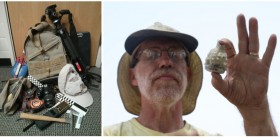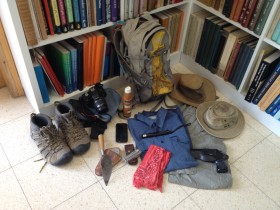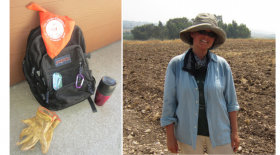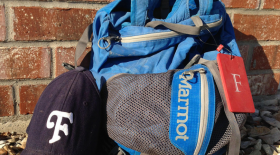What’s in your dig bag, Mark Schuler?
A typical day pack won’t work at our site. We have a bit of a daily hike up the mountain and must carry everything except large tools. Since basalt tends to be rough on nylon, I use a Maxpedition - Vulture-II™ backpack. It holds 34 liters of […]
What’s in your dig bag, Jennie Ebeling?
My dig bag may look ratty, but it’s special to me. I bought it 20 years ago in Tucson and it has all kinds of hidden pockets that occasionally yield surprises, like long-lost flash drives, old Burts Bees lip balms, and the key to the ground stone artifact […]
What’s in your dig bag, Eric Welch?
In our “What’s in your dig bag?” series, we asked working field archaeologists what they carry with them out in the field. We wanted to know what gear they love and what items might be unique to them. I’m a baseball hat guy. In my mind, the Indiana […]
10 Tips for Packing for a Dig
As the temperature starts to rise outside, many of us will pack our bags and head into the field. In archaeology, summer is a time for excavations and travel. Since a majority of these excavations will not likely be in your backyard, we here at ASOR thought we’d put together some tips for packing for […]
Excavating Village Life in Roman-Period Galilee
Alex Ramos, University of Pennsylvania, Platt Fellowship Recipient This summer, I was able to join the Samford University-led excavations of Shikhin, thanks in no small part to the ASOR fellowship that helped fund my stay. I was invited to come on as an area supervisor, in charge of the excavation and meticulous recording of two […]
The “Earthquake House” in Cyprus
Erin Daughters, Tandy Institute for Archaeology at Southwestern Baptist Theological Seminary, Platt Fellowship Recipient Every day at Kourion, Cyprus, thousands of tourists arrive to see the beautiful mosaics, monumental buildings, baths, and theatre. My little sliver of Kourion, located to the southeast of the major architecture, is less visited. We have a few groups come […]
Journal of a Rowanduz Archaeological Project (RAP) Participant
By: Kyra Kaercher, PhD Candidate and 2013 Platt Fellowship Recipient Department of Archaeology, Boston University June 6th While waiting for our permit to be signed for the Rowanduz Archaeological Project (RAP), we went to a few gatherings hosted by the Mayor of Rowanduz. RAP is a project located in Northern Iraq, in the Autonomous Kurdish Region. This project is a […]
2013 Platt Fellowship: From Student to Supervisor in Cyprus
By: Lydia Dwyer Platt Fellowship Recipient The ancient city-state of Idalion was once one of the largest copper-producing cities on Cyprus. The volcanic hills of the island hide copper-rich pillow lavas that Idalionites would mine, process, and then export to one of the port cities. Dr. Pamela Gaber has operated the site since 1987, […]
Recipe for Surviving an Archaeological Excavation
By: Marielle Velander Meyers Fellow I’m already halfway through my three weeks as an archaeologist at Tel Kabri, a Middle Bronze Age palace in northwestern Israel, my participation made possible by the Meyers Fellowship through the American Schools for Oriental Research (ASOR). I’ve learned a lot already about what is necessary to get through […]
Digging the Iron Age at Bethsaida
By: Olga Goussev-Sushinsky Heritage Fellow For my first archaeological dig, I decided to choose Bethsaida. The site is located at north-east shore of the Sea of Galilee and is most known for its role in the New Testament. It is also renowned for being the capital of the Biblical kingdom Geshur. Led by Dr. […]
Excavating Canaanite remains at Tel Jezreel
By: Ashley Motes Heritage Fellow From May to June, I spent four weeks at Tel Jezreel in Israel participating in the Jezreel Expedition. Norma Franklin of Zinman Institute of Archaeology at Israel’s University of Haifa and Jennie Ebeling of University of Evansville were the directors of the project. The focus of the Jezreel Expedition is […]
Shalom from Huqoq, Israel!
By: Megan Hynek, 2013 Platt Fellowship recipient Deciding to dig in Israel was an easy decision. I am currently a fourth year archaeology student at the University of North Carolina at Chapel Hill. All archaeology students there are required to attend a dig field school. We have several options including digs in northern Peru, Mississippi, and […]
Archaeological Field Work in Egypt After the Revolution
By: James K. Hoffmeier, Trinity International University On January 25 the Egyptian revolution that toppled the thirty-year dictatorial reign of Hosni Mubarak began. On February 11th, Mubarak resigned. While the political news gripped much of the world, reports of some looting in the Cairo museum surprised everyone. Though limited in scope, security was quickly […]
Tel Hazor Bronze Age Photo Gallery
Photo Gallery: Here’s a gallery all the images that appear in Near Eastern Archaeology 76.2 for Hazor in the Middle and Late Bronze Ages. Smaller versions of some of the images also appear to illustrate the abridged version of the article on Hazor’s Ceremonial Precinct found on the ASOR Blog / ANE Today which you can […]
The Ceremonial Precinct in the Upper City of Hazor: What Does the Identification As a Temple or Palace Have to Do With Joshua’s Conquest?
ANE Today Editorial Introduction:* Hazor, “the head of all those kingdoms,” has a unique place in Biblical Archaeology. It is the largest tell in the Southern Levant, and a city-state whose importance resonated throughout the Middle and Late Bronze Ages. Hazor is also specifically named in the Book of Joshua as one of the enemies […]
Near Eastern Archaeology in Malta
By: Anthony J. Frendo The Maltese archipelago lies practically at the centre of the Mediterranean, roughly midway between the eastern and the western Mediterranean Sea, and between the island of Sicily to its north and Libya to its south. Given this unusual location – between the Near East and Classical worlds and at the epicenter […]
Archaeology in Lebanon Today: Its Politics and Its Problems
By: Hélène Sader Lebanon has a long and very rich past, but in spite of the country’s wealth of ancient settlements, compared to neighboring countries archaeological research is far behind. While in the last decades archaeological research has greatly enhanced our understanding of Syria’s, Jordan’s, and Palestine’s past, Lebanon appears to be lagging behind and […]
That’s a Wrap
This month we focused on archaeology in the Digital Age, featuring seven posts on new issues arising in the field such as open access in academic publishing and incorporating new technology into fieldwork and research. Check out the articles below and let us know what you think in the comments. Have you tried going paperless […]
Turning Dirt into Pixels
By: Colleen Morgan CLEAN * PHOTOGRAPH * DRAW * LEVEL * RECORD * SAMPLE * DIG * SORT ARTIFACTS * REPEAT In archaeological field work it is easy to become entranced. We have a cyclical mode of work, and it is this work that field archaeologists like the best, the kind that happens when the […]






